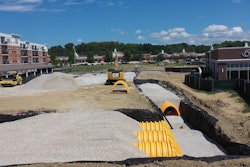
Join, the Oakland, Cal.-based decision support platform for contractors, architects, engineers and the building team, announces the launch of Join Forecasting, their new functionality that combines historical project data for project comparisons and conceptual estimates.
Design-build contractors, construction managers and design teams all need to make good decisions based on the information available to them from the current and past projects. Even if you can unite data from these different sources effectively for your own decision support, these decisions are often the result of a collaborative process between different project stakeholders. While there are a number of analytics tool that may be useful for an individual, Join supports group decisions and helps each stakeholder understand the impact of each decisions on their roles in the project.
Join is a software-as-a-service (SaaS) solution that facilitates this type of decision making in construction — and it is the ability to make more profitable decisions that, according to the company, has helped Join customers grow their new bookings 14% more than competitors with similar revenue and size. New contract volume was also 10% higher than similar competitors. Founded in 2017, Join has a book of customers ranging in size from a million or so dollars up to Clark Construction, DPR Construction, McCarthy, and the STO Building Group. The software is aimed primarily at contractors and designers engaged in collaborative delivery methods like design-build, construction manager at risk, engineer procure construct or integrated project delivery and target value design.
The company has received about $20 million in funding, including a Series A round in June of 2022 and a seed round in June of 2019.
Join Forecasting adds to the Join suite a comparison feature enabling contractors and their teams to collect historical estimates and other current project data into one location. From there, they can easily catalog, access and share accurate project information, supporting transparency and informed solutions throughout the life of a project in order to:
- Collect historical project data and current and future data and store it in a central, accessible and searchable location
- Create comparison and estimate reports and presentations
- Share the data behind the estimate so owners gain confidence in their experience and have assurance that projections are realistic
Focused on Construction Cost
“Join is a platform that helps teams make decisions faster, make decisions better and make decisions they are confident about and will stick,” Join Co-Founder Andrew Zukoski said in an IronPros debriefing prior to the launch of the new Join Forecasting tool.
While analytics tools like Green Badger and cove.tool handle functions similar to this for environmental performance and LEED documentation, Join is focused primarily on project cost. Decisions around design elements or change orders, with Join, are made based on cost data on design elements or changes, design team feedback, cost data from trade partners or subcontractors and other data provided by stakeholders on the project team.
“We can then trend that information as owners are making decisions,” Zukoski said. “We see that a typical construction project has about one to two thousand decisions that will impact the price and you need the owner to make those decisions they will impact their budget or their business case. If you are going to get through the project in a reasonable period of time, you need to make these decisions quickly even as they are overlapping and you need to avoid making conflicting ones.”
The ability to make decisions in context is important, as illustrated recently in a customer project.
“Most of our customers are general contractors, but we were working in one case I can recall with a design firm,” Zukoski said. “They were going through a value engineering exercise because they were over budget and in Join they could see the general contractor was pushing for a certain dollar value in cost savings. The team was discussing certain decisions around the façade and surfaces in a highly-trafficked part of the inside of the building. The designer was able to point out the importance of these finishes the design intent, and the team was able to make these cost savings in other areas of the project.”
Join integrates through its application programming interface (API) with estimating packages including Trimble Winest, Sage, Beck Technology's DESTINI estimating software and Excel. This is often accomplished by estimating and importing a static file or unidirectional integration from the estimating package into Join.
“Some of our customers are going for bidirectional integrations,” Zukoski said. “Most teams develop an estimate and bring it into Join to manage what the cost will actually be. Individual cost items can be associated with a classification and where they are in the work breakdown structure. We can add some information on how the cost is built up including balance of labor, equipment and material.”
Join also has preliminary integrations in place with Procore and Autodesk Construction Cloud. These integrations are on track to be expanded to also include document management.
Join Market and Pricing
Since Join addresses change orders, the product may appear to have some functional overlap with change order management platform Extracker. But Extracker and Join share an investor—Building Ventures—which does not invest in competing companies. More direct competitors may be Moca, Alliane2Build and LagosPM.
“Some teams use Join for change orders, but we live more in the pre-construction phase,” Zukoski said. “We think of ourselves as decision-making software or another way our customers say it is a target value design platform. We had thought target value design was a practice that only the crazies completely invested in lean were doing—but now it is showing up all over the place.”
An ideal contractor fit for the Join platform is doing about 40% to 50% of their business through collaborative, shared risk models like design build, construction management at-risk or IPD. Contractors do not need to be large to benefit — contractors from the low tens of millions of dollars in revenue are on the platform, as well as larger contractors with hundreds of millions of dollars. Contractors engaged strictly in single family home construction are less of a fit, as are contractors strictly engaged in jobs smaller than a million dollars of construction value.
Contractors and design firms pay for Join based on the value of work they send over the platform. Price breaks based on a percentage of value kick in continuously as construction volume increases. As volume gets high enough, Join offers enterprise pricing that is no longer based on volume.
“There is a very natural expansion inside our customers where, once we get in the door, they bring one office or line of business’s work, and then roll Join out elsewhere.”



















